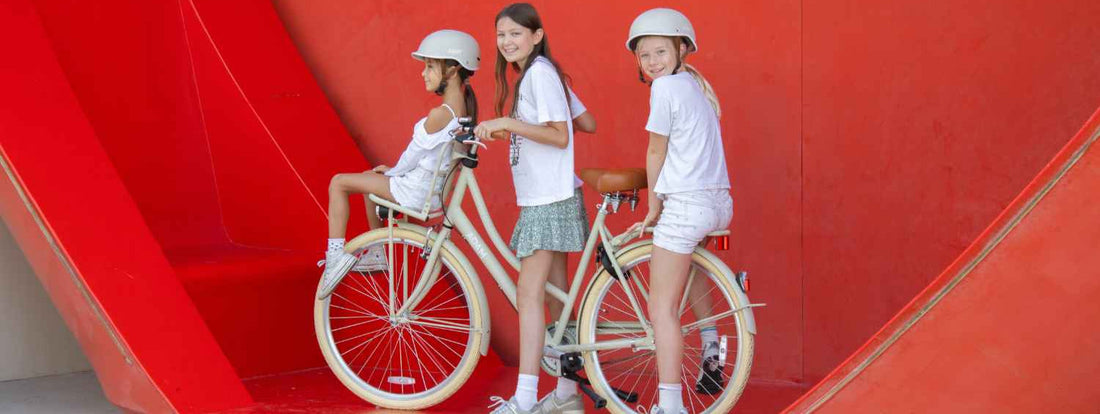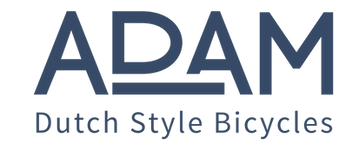
Coaster Brake vs. Handbrake: Choosing the Right Brake System for Your Bike
Share
This guide will help you understand both braking systems - from Dutch-style coaster brakes to responsive handbrakes - so you can choose what works best for your Dubai cycling adventures.
Picture this: you're cruising down a gentle slope in Dubai Marina when you need to stop for a friend. Do you instinctively reach for brake levers, or do you pedal backward? Your answer reveals more about your cycling style than you might think.
Choosing between coaster brakes and handbrakes isn't just about personal preference. It's about matching the right system to your riding style, terrain, and family's needs in Dubai's unique cycling environment.
Understanding Coaster Brakes: The Dutch Approach
Coaster brakes represent the essence of Dutch cycling philosophy: elegant simplicity.
Built directly into your rear hub, they work through one intuitive motion - pedal backward to stop. No cables running along your frame, no brake levers to squeeze, no complicated mechanisms to maintain.
How they work: When you pedal forward, everything moves smoothly. The moment you backpedal, internal brake shoes press against the hub, creating friction that stops your bike. A reaction arm keeps everything stable, securely attached to your frame.
This design has powered millions of Dutch cyclists for generations, proving that sometimes the simplest solution is the most reliable.
Check out: Which country uses bicycles the most?
Understanding Handbrakes: Precision and Control
Handbrakes offer immediate, controllable stopping power through familiar squeeze-and-stop action.
When you squeeze a brake lever, cables or hydraulic systems activate brake pads that grip your wheel rims or disc rotors. This direct connection between your hands and wheels provides instant response and precise control over braking force.
The advantage: You can modulate braking from gentle slowing to emergency stops, using both wheels for maximum stopping power and maintaining full control throughout the process.
The Real-World Comparison
Let's examine how each system performs in Dubai's cycling conditions:
Stopping Power and Distance
Handbrakes: Superior stopping power using both wheels. Typically reduce stopping distance by 20-30% compared to rear-only braking systems. Essential for emergency situations or steep terrain.
Coaster Brakes: Reliable stopping power for casual riding, though limited to rear wheel only. Perfectly adequate for flat terrain and leisure cycling at moderate speeds.
Dubai Climate Performance
Both systems handle Dubai's conditions well, though differently:
Handbrakes: External components require occasional adjustment due to cable expansion in heat. However, disc brakes perform consistently regardless of weather conditions.
Coaster Brakes: Internal mechanisms stay protected from sand and dust. Heat buildup can occur during extended braking but rarely affects casual riding.
Maintenance Reality
Handbrakes: Regular but simple maintenance. Cable adjustments, brake pad replacement, and cleaning are straightforward and affordable.
Coaster Brakes: Lower maintenance frequency but higher costs when service is needed. Internal hub work requires specialized knowledge but intervals between services are longer.
When Coaster Brakes Excel
Coaster brakes shine in specific Dubai cycling scenarios:
Family Neighborhood Rides: Perfect for exploring residential areas, parks, and flat coastal paths. Simple operation lets you focus on enjoying the ride rather than managing controls.
Kids Learning to Cycle: One less thing to think about while mastering balance and steering. Children often find pedal-backward motion more intuitive than hand coordination.
Relaxed Urban Transport: Ideal for short trips to cafes, grocery stores, or Metro stations where cycling speeds stay moderate and terrain remains predictable.
Low-Maintenance Cycling: Great for occasional riders who prefer minimal bike maintenance and maximum simplicity.
Adam Bike Tip: Our Classic Adam with coaster brake offers the authentic Dutch cycling experience - perfect for Dubai families wanting simple, reliable transportation that works straight out of the box.
When Handbrakes Are Essential
Dubai's diverse cycling opportunities often demand handbrake precision:
Varied Terrain: From Dubai Marina's bridges to Business Bay's inclines, handbrakes provide confident control over changing elevations and gradients.
Family Safety: When cycling with children in traffic areas or busy parks, immediate stopping response can make crucial safety differences.
Cargo Cycling: Additional weight from groceries, school bags, or passengers requires maximum stopping power that only dual-wheel braking can provide.
Performance Riding: Any cycling beyond leisurely pace - fitness rides, longer distances, or group cycling - benefits from handbrake control and responsiveness.
Adam Bike Tip: Our expanding handbrake collection includes models designed specifically for Dubai's cycling conditions, combining reliable stopping power with comfortable everyday riding.
The Best of Both Worlds
Many cyclists discover that combination systems offer optimal versatility:
Coaster + Front Handbrake: This setup provides coaster brake simplicity for normal riding while adding front wheel stopping power for situations requiring extra control. It's like having a safety net for varied conditions.
Dual Handbrake Systems: Two handbrakes (front and rear) deliver maximum stopping power and control. Essential for electric bikes, cargo cycling, or performance-oriented riding.
Adam Bike Tip: Our adult bicycle range includes both combination and dual handbrake options, letting you choose the level of control that matches your cycling ambitions.
Electric Bikes: Handbrakes Only
Electric assistance changes braking requirements significantly:
Higher Speeds: E-bikes naturally achieve higher speeds, demanding immediate stopping response that only handbrakes can provide reliably.
Increased Weight: Bike plus battery weight requires maximum stopping power from both wheels for safe, controlled stopping.
Regenerative Braking: Many e-bikes feature energy recovery systems that work through handbrake levers, adding efficiency while you stop.
Urban Integration: Dubai's growing e-bike infrastructure assumes handbrake-equipped bikes for traffic integration and safety compliance.
Adam Bike Tip: Our Electric Adam uses premium handbrake systems designed for Dubai's urban cycling, ensuring confident stopping power whether you're commuting to work or exploring the city with family.
Kids' Bikes: Matching System to Development
Children's cycling development influences brake choice significantly:
Beginning Riders (Ages 3-6)
Coaster brakes often work better during initial learning phases. One motion to master, intuitive pedal-backward action, and less overwhelming control complexity.
Developing Cyclists (Ages 6-10)
Both systems can work well, depending on intended use. Neighborhood cycling might favor coaster simplicity, while park adventures might benefit from handbrake control.
Young Adventurers (Ages 10+)
Handbrakes become increasingly important as cycling skills and ambitions grow. Mountain biking, longer rides, and group cycling all benefit from precise braking control.
Adam Bike Tip: Our kids' bicycle range includes both brake types, letting you match the system to your child's development stage and cycling environment rather than forcing a one-size-fits-all approach.
Installation and Service Considerations
Understanding maintenance requirements helps inform your choice:
Coaster Brake Service
- Professional hub service every 2-3 years
- Higher service costs (AED 400-800) but longer intervals
- Specialized knowledge required for internal mechanisms
- Weather-resistant design reduces frequency needs
Handbrake Service
- Regular cable and pad maintenance (AED 80-160 annually)
- DIY-friendly basic adjustments possible
- More frequent but lower-cost service needs
- Widely serviceable by most bike shops
Adam Bike Tip: We provide comprehensive service support for both brake systems, ensuring your choice works reliably regardless of which system matches your needs best.
Making Your Decision
Choose based on your actual riding patterns:
Coaster brakes when you prioritize: Simplicity, low maintenance frequency, authentic Dutch cycling experience, kids' learning ease, flat terrain riding.
Handbrakes when you need: Maximum stopping power, varied terrain confidence, emergency response capability, cargo capacity, electric assistance, performance cycling.
Combination systems when you want: Versatility for mixed riding conditions, coaster simplicity with handbrake backup, family cycling flexibility, system redundancy.
The Dubai Cycling Reality
Dubai's cycling infrastructure accommodates both systems well, but certain conditions favor specific choices:
Marina and JBR cycling: Flat, predictable terrain where coaster brakes excel for leisure family rides.
Business Bay and Downtown: Variable terrain and traffic proximity where handbrakes provide confidence and control.
Al Qudra and longer rides: Distance and varied conditions where handbrake precision becomes valuable.
School runs and daily transport: Mixed urban conditions where combination systems offer flexibility.
Check out: Cycling in Dubai: 7 Best Cycling Tracks & Complete Guide
Your Next Steps
Consider these questions to guide your choice:
- Where will most of your cycling happen?
- What speeds do you typically maintain?
- Are you cycling alone or with family?
- How important is minimal maintenance versus maximum control?
- Does your cycling ambition extend beyond current experience?
Visit The Adam Store for personalized brake system guidance. Our team understands Dubai's cycling conditions and can help match brake systems to your family's specific needs and cycling goals.
Whether you're drawn to coaster brake simplicity or handbrake precision, we'll ensure your choice enhances rather than complicates your Dubai cycling experience.
Your perfect braking system is the one that makes you feel confident and comfortable on every ride.
FAQ
Which brake system is safer for Dubai cycling?
Both can be safe when properly matched to use case. Handbrakes provide better emergency stopping and control for varied conditions. Coaster brakes excel for predictable, flat terrain riding where simplicity reduces user error.
Can I upgrade from coaster brakes to handbrakes later?
Usually possible but requires significant modification including new wheels or hubs. Consider your long-term cycling plans when making initial brake choice rather than planning upgrades.
Do professional cyclists use coaster brakes?
Competitive cycling exclusively uses handbrakes for immediate response and precise control. Coaster brakes serve different cycling purposes - enjoyable, practical transportation rather than performance riding.
Which system works better for Dubai's heat?
Both handle heat well but differently. Coaster brakes' internal design protects from dust and sand. Handbrakes may need minor cable adjustments due to thermal expansion but perform consistently in all weather.
Are handbrakes harder for kids to learn?
Not necessarily - it depends on the child. Some find handbrakes more intuitive, others prefer coaster brake simplicity. Consider your child's coordination development and intended riding environment.
Can I get both systems on one bike?
Yes - combination systems (coaster rear + handbrake front) offer versatility for mixed riding conditions. Many cyclists find this setup provides both simplicity and control when needed.
What is a coaster brake?
A coaster brake is a type of brake integrated into the rear hub of a bicycle. Unlike traditional hand-operated brakes that use brake levers and rim brakes or disc brakes, a coaster brake is activated by pedaling backward. This simple braking device allows riders to stop the rear wheel by applying reverse pressure on the pedals. It's commonly found on Dutch Style Bicycles and kids' bikes due to its straightforward design and ease of use.
How does a coaster brake work?
The coaster brake operates through a mechanism inside the bicycle's rear hub. When you pedal forward, the bike moves as usual. However, when you begin backpedaling, the coaster brake is activated. This action engages internal brake shoes against the hub, generating friction and providing the necessary braking force to slow down or stop the bike. The absence of external cables and brake levers makes it a low-maintenance option. The reaction arm attached to the frame prevents the hub from rotating, allowing the brake to function effectively.
